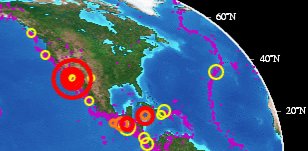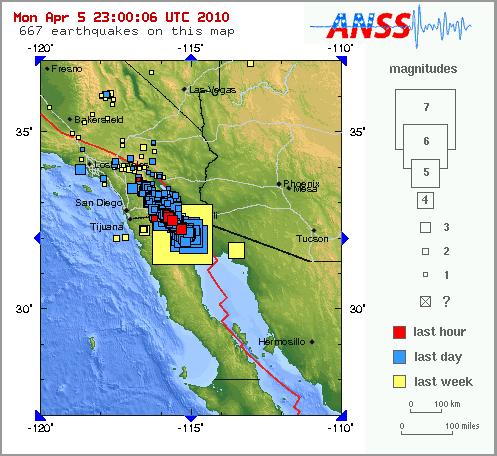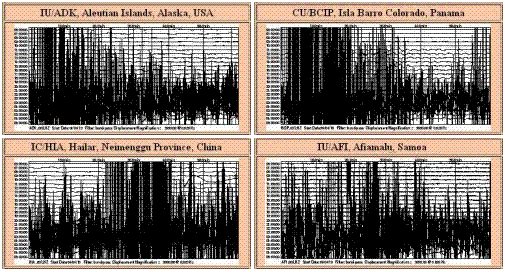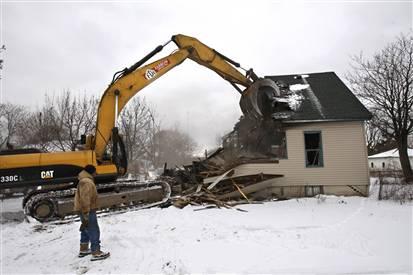Baja Bow Breaks
San Diego is in as the center of a bow caused by pulling the Aleutian Island and the tip of Mexico
toward each other, as presented in Issue 167 of this newsletter on January 10, 2010. The Zetas
describe this as a bow, which will not be relieved until the New Madrid fault lines rupture. A that time,
between December 31, 2009 and January 1, 2010, the Baja region had just experienced a 5.8 followed
by many aftershocks. Now this has occurred again, on April 4, 2010, with the Baja experiencing a 7.2
or so (the number keeps changing).

- Major Quake in Mexico Rocks Southwestern US
April 5, 2010
http://www.latimes.com/news/nationworld/nation/wire/ktla-earthquake,0,6948498.story
- A 7.2 magnitude earthquake centered in Baja California, Mexico was felt all over Southern
California, rocking high rise buildings from San Diego to Los Angeles, but there were no
immediate reports of major damage. After examining data, seismologists upgraded the size
of Sunday's 25-second quake from a magnitude 6.9 to 7.2. According to reports, the
temblor's force caused high-rise buildings in San Diego to sway back and forth around 30
seconds before rocking high-rise buildings in downtown Los Angeles. Strong shaking was
reportedly felt as far away as Las Vegas, Nevada and Yuma, Arizona.
The aftershocks over the next few hours were many and large in and of themselves. Was the magnitude
underplayed? Potentially. There are reports of the quake being felt in Phoenix and Los Vegas, and
aftershocks in Utah.

- Aftershocks Continue to Shake Southern California
April 5, 2010
http://apnews.myway.com/article/20100405/D9ESUJS00.html
- Buildings shook as far away as Phoenix and Las Vegas, but most of the U.S. damage
appeared to be limited to California's southeastern Imperial Valley. In Nevada, the quake
was felt in the fire and medical dispatch center in downtown Las Vegas, but there were no
reports of damage or injuries, according a spokesman for Las Vegas Fire and Rescue.
Jacqueline Land said her king-sized bed in her second-floor Phoenix-area apartment felt
like a boat gently swaying on the ocean.
One of the aftershocks hit my home state (Utah), with a 4.3, although I didn't
actually feel anything. 2010-04-05 01:26:08. 4.3 Utah News
Magnitude is measured by the strength of the initial jolt and the scope affected. The larger the area
affected, the larger the magnitude. Compare the descriptions above of the area affected by the March 4,
2010 Baja quake to this graph, showing the area affected by a 6.7 quake in 1994 in Southern
California. There, the quake seemed restricted to California, just at the border of Arizona and Nevada,
and Utah was certainly not affected at all. Thus, the recent Baja quake could have been larger than a
7.2, as the USGS has its foot on the brake all the time, trying to downplay how many quakes the Earth
is experiencing of late and their severity.

Another way to determine the strength of the recent Baja quake is how the rest of the world reacts.
Really large quakes, or those that move the plates, set the magma to sloshing, so the live seismographs
tend to go black. The whole world participates. This happened during the magnitude 9.5 quake on
December 26, 2004 in Sumatra, and recently during the magnitude 8.8 on February 27, 2010 in Chile
quake. Does a 7.2 in Baja compare in some way? The live seismographs think so.

Slum Survival
The Zetas have warned that those living in cities will not fare well during the coming pole shift. City
dwellers rely upon food distribution, food brought into the city, and almost invariably have zero skills in
how to grow their own food. The Zetas paint a grim picture.
ZetaTalk Warning 6/30/2007: Cities will be death traps, as we have endlessly explained. The
problem is not just when this will start, as a strong wobble, a lean to the left, will cause the
establishment in many countries to impose travel restrictions. Rioting will break out, as the
populace may be in panic, and martial law will be imposed on cities first, even in countries very
liberal with their populace. Travel restrictions are seen as a way of protecting the citizenry from
rioting and looting. Just imagine a city populace pouring out into the countryside! How would
this be policed? At best, cities will be empied into tent cities, where starvation sets in due to food
shortages and distribution problems and brutal control over rioting is enforced. Thus, the fact
that cities are death traps may be a door that slams shut for city dwellers at the very onset of
severe Earth changes. What will occur in cities? Starvation as food runs out, looting and roiting
as the police become overwhelmed or leave the areas, buildings toppling down on the populace,
hospitals overwhelmed, sewage rupturing into the streets and ruining drinking water, and an
inability to escape this mess. Few will last or escape, and this will be the case in all countries.
The population of cities is growing, not shrinking. Even the slum portions of cities are growing at the
present time, though governments try desperately to find jobs for slum dwellers. This is, per a UN
report, a losing battle.
- World's Slums Grow Despite Rapid Economy Growth: UN
March 19, 2010
http://news.yahoo.com/s/nm/20100319/wl_nm/us_un_cities
- Almost a quarter of a billion people moved out of slum conditions in the past decade,
driven by rapid economic growth in emerging giants India and China, but the number of
people living in them continues to rise. The number of people living in shantytowns
increased by 55 million to 827.6 million as population growth and migration from the
countryside outstripped the effect of upward mobility in cities, the UN's biennial report on
cities found. The Brazilian city will next week host the World Urban Forum, a five-day UN
conference on the state of the world's cities, where more than half the global population
now lives.
Half the global population now lives in cities! And in addition, most cities are in unsafe zones, along
coastlines where shipping hubs were established, or in river bottom land where commerce was
facilitated by river barges. In addition to likely being trapped in the cities, due to travel restriction during
the last days, per the Zetas most city dwellers will stick to the cities, and even try to return to them in the
days after the pole shift, looking for their familiar lifestyle.
ZetaTalk Prediction 8/22/2009: The first thought of those who have vacated the cities and
suburbs will be to return to shopping, in a manner of speaking. It is easier to turn back to the
grocery store, the hardware store, the Walmart, than to press forward through rural lands into
unknown country. This is true because those who linger in the cities and do not educate
themselves about gardening or saving seed and the like, and who have not developed the skill
sets necessary for self sustained living, will return to the old and familiar. What's wrong with this
approach? Looting will be rampant, and when goods become scarce, as they will almost
immediately, looters will get vicious and steal from one another. We also raised the specter of
canibalism. This is in any case a short term solution, and then you will have to turn outward into
rural or wilderness areas.
So what is city management to do, if they are secretly aware of the coming pole shift, but told under no
uncertain terms that they must keep their mouths shut, as this is a national security directive? According
to a recent article on Detroit's approach - raze old buildings and establishing gardening, right in the city
proper!

- Detroit Wants to Save Itself by Shrinking
March 8, 2010
http://www.msnbc.msn.com/id/35767727/ns/us_news-life/
- Detroit, the very symbol of American industrial might for most of the 20th century, is
drawing up a radical renewal plan that calls for turning large swaths of this now-blighted,
rusted-out city back into the fields and farmland that existed before the automobile.
Operating on a scale never before attempted in this country, the city would demolish
houses in some of the most desolate sections of Detroit and move residents into stronger
neighborhoods. Roughly a quarter of the 139-square-mile city could go from urban to
semi-rural. Politically explosive decisions must be made about which neighborhoods should
be bulldozed and which improved. Hundreds of millions of federal dollars will be needed to
buy land, raze buildings and relocate residents, since this financially desperate city does not
have the means to do it on its own. It isn't known how many people in the mostly black,
blue-collar city might be uprooted, but it could be thousands. Some won't go willingly.
Detroit is broke, and federal funds are hard to come by too these days, so where will the funds come
from? Apparently, in part, from private investors! Benefactors, is the word that applies, most likely.
- Detroit Poised to Get First Commercial Urban Farm
April 3, 2010
http://www.detnews.com/article/20100403/
- The city's first commercial urban farm is being planned for 40 acres at the Michigan State
Fairgrounds and some crops could be planted as early as this spring or summer. For a
year, Hantz - a financial services mogul - has been vocal about his plan to pursue
commercial urban farming in Detroit. But he hasn't indicated where he might locate a
farm. Hantz lives in Detroit, where he has renovated eight houses in Indian Village. His
firm is located in Southfield. In the past, he's said he is willing to invest up to $30 million of
his own fortune to create a model for reclaiming a post-industrial city. The parks authority,
meanwhile, has agreed to submit a final business plan to the state by the end of April. "We
are getting very short of time, obviously," Weiss said. While the city already has many
nonprofit urban farming sites that operate as community gardens, Hantz wants to take
another route. He contends that large-scale farms could provide a way to restore value to
Detroit's vast, fallow acreage. "We want to make Detroit the urban agriculture center of
the world," said Hantz's spokeswoman.
Per the Zetas, this is one way those of good heart can try to get the populace pointing in the right
direction.
ZetaTalk Comment 4/3/2010: Razzing urban blight and installing gardens in an urban area is
indeed a survival community step. This is one way those in the know can encourage
self-sufficiency, without breaking the cover-up over the presence of Planet X.
Toyota Recall Cause
Were Toyota's problems, requiring a recent recall of their cars due to runaway acceleration, caused by
faulty design and sticky accelerators or something else? Per the Zetas, it is both.
ZetaTalk Comment 3/13/2010: A periodic malfunction due to electromagnetic pulse would not
cause a mass recall, though some of the incidents were due to external electromagnetic
interference. As with all devices dependent upon a steady electrical or magnetic environment,
cars as well as planes and trains will continue to malfunction, increasingly. There is no predicting
what area, or what timeframe, such malfunction will strike.
So some of the incidents were due to electromagnetic pulse, which certainly caused Air France 447 to
lose all of its electrical systems and crash. Cars are increasingly controlled by computers, electronics, so
presumably would likewise be vulnerable.
- Are Cosmic Rays Really Causing Toyota's Woes?
March 16, 2010
http://www.abovetopsecret.com/forum/thread554716/pg1
- It may sound far-fetched, but federal regulators are studying whether sudden acceleration
in Toyotas is linked to cosmic rays. Radiation from space long has affected airplanes and
spacecraft, and is known for triggering errors in Computer systems, but has received scant
attention in the auto industry. The questions show how deep regulators and automakers
may have to dig to solve the mysteries of sudden acceleration. Toyota says it is fixing
mechanical problems - floor mats and sticky pedals - that explain sudden acceleration in
13 models and 5.6 million vehicles. With more than 3,000 complaints to U.S. regulators of
random sudden acceleration problems in Toyota models, several researchers say single
event upsets deserve a close look. The phenomenon can trigger software crashes that come
and go without a trace. Unlike interference from radio waves, there's no way to physically
block particles; such errors typically have to be prevented by a combination of software
and hardware design.
Is the establishment concerned about electronics affected by the electromagnetic pulse from the charged
tail of Planet X?
ZetaTalk Answer 2/17/2007: We have stated that electromagnetic surges will occur, increasingly,
as Planet X approaches and in particular as the tail wafts past the Earth. The compass has been
erratic for a couple years now, but as the tail is charged, will have more problems than the past.
The magnetic fields of Planet X and Earth clash, and this is not a steady state but a surging
affair.
Apparently so, as the auto industry is going to get an assist from NASA!
- NASA Will Help Probe Toyota Accelerators
March 30, 2010
http://www.bloomberg.com/apps/news?pid=20601087&sid=ayd_M.kAzH.M&pos=7
- NASA and the National Academy of Sciences are joining the government's effort to figure
out what caused the sudden acceleration problems that led to Toyota's massive recalls.
NASA scientists with expertise in electronics will help the National Highway Traffic Safety
Administration study potential electronic ties to unintended acceleration in Toyotas.
NASA's knowledge of electronics, computer hardware and software and hazard analysis
will ensure a comprehensive review, Transportation Secretary Ray LaHood said. In a
separate study, the National Academy of Sciences will examine unwanted acceleration and
electronic vehicle controls in cars from around the auto industry. The National Academy is
an independent organization chartered by Congress.
You received this Newsletter because you Subscribed to the ZetaTalk Newsletter service. If undesired, you can quickly
Unsubscribe. You can always access prior Newsletters from the Archives.
|

